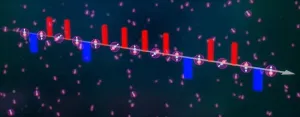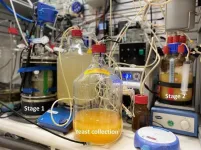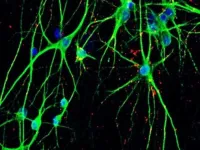The insulator unraveled
2024-09-12
(Press-News.org)
Aluminum oxide (Al2O3), also known as alumina, corundum, sapphire, or ruby, is one of the best insulators used in a wide range of applications: in electronic components, as a support material for catalysts, or as a chemically resistant ceramic, to name a few. Knowledge of the precise arrangement of the surface atoms is key to understanding how chemical reactions occur on this material, such as those in catalytic processes. Atoms inside the material follow a fixed arrangement, giving rise to the characteristic shapes of crystals. On the surface, however, the structure deviates from that inside the crystal. The strongly insulating nature of alumina hindered experimental studies, and the surface structure evaded precise determination for more than half a century. Researchers at TU Wien and the University of Vienna have now solved the complex structure of the Al2O3 surface, a puzzle listed in 1997 as one of the “Three mysteries of surface science”. The research group led by Jan Balajka and Ulrike Diebold recently published their findings in the prestigious journal Science.
High-resolution microscopy identifies surface atoms
The research team used noncontact atomic force microscopy (ncAFM) to analyze the surface structure. This method generates images of the surface structure by scanning a sharp tip mounted on a quartz tuning fork at a close distance from the surface. The frequency of the tuning fork changes as the tip interacts with the atoms on the surface without touching the material. Johanna Hütner, who performed the experiments, explains: "In an ncAFM image, one can see the location of atoms, but not their chemical identity. We overcame the lack of chemical sensitivity by precisely controlling the tip. Attaching a single oxygen atom to the tip apex allowed us to distinguish between oxygen and aluminum atoms on the surface. The oxygen atom on the tip is repelled from other oxygen atoms at the surface and attracted to aluminum atoms of the Al2O3 surface. Mapping the local repulsion or attraction enabled us to visualize the chemical identity of each surface atom directly."
Restructuring stabilizes the surface without changing its composition
The researchers found that the surface rearranges to allow the aluminum atoms at the surface to penetrate into the material and form chemical bonds with the oxygen atoms in the deeper layers. This rearrangement of the first two atomic layers significantly reduces the energy, effectively stabilizing the structure. In contrast to previous beliefs, the numerical ratio of aluminum to oxygen atoms remains unchanged.
The three-dimensional model of the aluminum oxide surface was optimized with machine learning methods. The main challenge was to match the restructured surface with the underlying crystal. "The structure is very complex, resulting in a vast number of possibilities for how the experimentally inaccessible atoms below the surface could be arranged. The state-of-the-art machine learning algorithms combined with conventional computational methods allowed us to examine numerous possibilities and create the stable three-dimensional model of the aluminum oxide surface," states Andrea Conti, who carried out the computational modeling.
"Through the collaborative effort of experimental and computational research, we not only tackled a long-standing mystery by determining the detailed structure of this enigmatic insulator, but also discovered structure design principles applicable to an entire class of materials. Our results pave the way for advancements in catalysis, material science, and other fields," says Jan Balajka, who led the research.
Parts of the experimental setup housing the noncontact atomic force microscope have been patented: Passive vibration isolation for high-resolution microscopy.
END
[Attachments] See images for this press release:
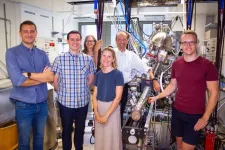
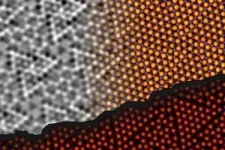
ELSE PRESS RELEASES FROM THIS DATE:
2024-09-12
ATLANTA — A new three-year, $3.5 million grant from the U.S. National Science Foundation will foster new research at Georgia State’s Center for High Angular Resolution Astronomy (CHARA) Array by astronomers from around the world.
The grant will fund open-access time at the CHARA Array through the NSF National Optical-Infrared Astronomy Research Laboratory (NSF NOIRLab). The program offers astronomers the opportunity to apply for observing time at the CHARA Array to investigate all kinds of objects ...
2024-09-12
The interactions between quantum spins underlie some of the universe’s most interesting phenomena, such as superconductors and magnets. However, physicists have difficulty engineering controllable systems in the lab that replicate these interactions.
Now, in a recently published Nature paper, JILA and NIST Fellow and University of Colorado Boulder Physics Professor Jun Ye and his team, along with collaborators in Mikhail Lukin’s group at Harvard University, used periodic microwave pulses in a process known as Floquet engineering, to tune interactions between ultracold potassium-rubidium molecules in a system appropriate for studying fundamental magnetic ...
2024-09-12
Researchers from Delft University of Technology in The Netherlands have been able to initiate a controlled movement in the very heart of an atom. They caused the atomic nucleus to interact with one of the electrons in the outermost shells of the atom. This electron could be manipulated and read out through the needle of a scanning tunneling microscope. The research, published in Nature Communications today, offers prospects for storing quantum information inside the nucleus, where it is safe from external disturbances.
For weeks on end, the researchers studied a single titanium atom. “A Ti-47 atom, to be precise,” ...
2024-09-12
Cardiovascular diseases are the leading cause of mortality in Western Europe, accounting for 1/3 of deaths in 2019. Diet is thought to be responsible for around 30% of such deaths. Nutrition-related prevention policies therefore constitute a major public health challenge for these diseases.
In an article to be published on 11 September 2024 in Lancet Regional Health - Europe, researchers from the Nutritional Epidemiology Research Team (CRESS-EREN), with members from Inserm, Inrae, Cnam, Université Sorbonne Paris Nord and Université Paris ...
2024-09-12
Landmark new research shows Ice Age teens from 25,000 years ago went through similar puberty stages as modern-day adolescents. In a study published today in the Journal of Human Evolution of the timing of puberty in Pleistocene teens, researchers are addressing a knowledge gap about how early humans grew up.
Found in the bones of 13 ancient humans between 10 and 20 years old is evidence of puberty stages. Co-led by University of Victoria (UVic) paleoanthropologist April Nowell, researchers found specific markers in the bones that allowed them to assess the progress of adolescence.
“By analyzing specific areas of the skeleton, we inferred things like menstruation ...
2024-09-12
Inflammatory bowel disease (IBD), encompassing Crohn’s disease (CD) and ulcerative colitis (UC), is a chronic inflammatory disorder of the gastrointestinal (GI) tract that significantly impacts the quality of life of patients. With an incidence of approximately one in 200 individuals in developed countries and a rising trend in developing and newly industrialized nations, IBD poses a substantial burden on healthcare systems. Due to the nonspecific nature of its clinical manifestations and the lack of a gold-standard diagnostic test, managing IBD effectively remains a challenge. Therefore, reliable and widely available biomarkers ...
2024-09-12
Researchers in Germany can harvest protein and vitamin B9 from microbes by feeding them nothing much more than hydrogen, oxygen, and CO2. The technology, published September 12 in the Cell Press journal Trends in Biotechnology, runs on renewable energy to produce a sustainable, micronutrient-enriched protein alternative that may one day make it to our plates.
“This is a fermentation process similar to how you make beer, but instead of giving the microbes sugar, we gave them gas and acetate,” says corresponding author Largus Angenent of the University of Tübingen, Germany. “We knew that yeast could produce vitamin B9 on their own with sugar, however, we didn’t ...
2024-09-12
Neurodevelopmental and psychiatric disorders (NPD) including schizophrenia, bipolar disorder, autism, and depression are detrimental to individuals, their families and society as a whole, and in many cases still lack effective treatments. It’s becoming more and more clear that genetic mutations in certain genes can increase the likelihood of developing NPD, and several hundreds of those “risk genes” have been identified to date, but their role related to NPD remains a mystery. “Very little is known about the basic function of most of these genes, and what we do know ...
2024-09-12
About The Study: This case report describes a woman who presented with bilateral blurry vision a few days after dyeing her hair with hair dye containing aromatic amines.
Corresponding Author: To contact the corresponding author, Nicolas Chirpaz, MD, email nicolas.chirpaz@chu-lyon.fr.
To access the embargoed study: Visit our For The Media website at this link https://media.jamanetwork.com/
(doi:10.1001/jamaophthalmol.2024.3453)
Editor’s Note: Please see the article for additional information, including other authors, author contributions and affiliations, conflict of interest and financial ...
2024-09-12
About The Study: This study found that certain social determinants of health affected monitoring for diabetic retinopathy similarly for Black and white patients with diabetes while others affected them differently. Patients living in rural communities, Black patients with preexisting diabetic retinopathy, and Hispanic white patients were not receiving eye care in accordance with clinical practice guidelines, which may contribute to worse outcomes.
Corresponding Author: To contact the corresponding author, Dustin D. French, PhD, email dustin.french@northwestern.edu.
To access the embargoed ...
LAST 30 PRESS RELEASES:
[Press-News.org] The insulator unraveled



